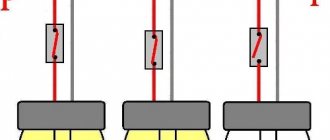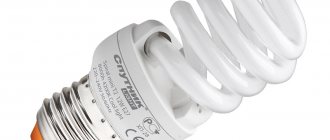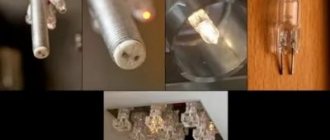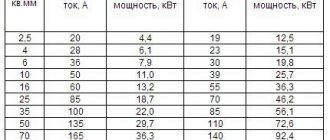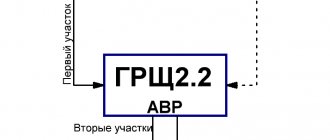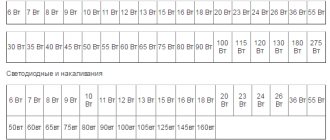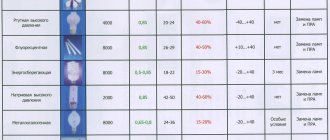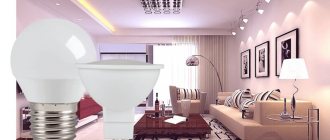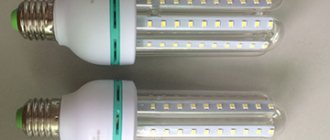Lumens
The light emitted by a source is called “luminous flux” and is measured in lumens (Lm). To make the choice easier, manufacturers indicate on the packaging the equivalent brightness in the familiar Watt system. But at home you discover that the 60 W LED analog shines somehow dimly. Why? Because you need to pay attention not to watts, but to lumens. It depends on them how light the room will be. This information is also indicated on the packaging, but only in small print.
The more lumens, the brighter the light. But be careful. The value in the same light bulbs from different manufacturers may not be the same. The type of base has nothing to do with it, it all depends on the quality of the components. In cheap Chinese samples, the numbers are much lower than in products from well-known brands.
Also, you should take into account the color of the light flux, or as it is also called - color temperature. It is measured in Kelvin (K) and is divided into 3 main types: warm (2700K), neutral (4000K) and cold (6000K). The latter is perceived as brighter, while neutral white corresponds to daylight.
Calculation of lighting by specific power
2015-05-26 16423
The method for calculating illumination but specific power is one of the simplified options for calculating illumination using a utilization factor.
The specific power of the lighting installation is determined by:
(12)
where RL -
power of one lamp, W;
F—
area of the illuminated room, m2.
Taking the specific power in accordance with the given conditions, you can determine the calculated value of the required power of one lamp:
( 13)
by which the lamp of the nearest standard power is selected.
In table 3.1-3.10 provide data on specific power for direct light fixtures with standard KSS [2].
Calculations using the specific power method can only be made for general uniform illumination in the absence of large shading and within the limits of the data for which the tables are compiled. When using them, the following features should be taken into account:
♦ if the value of illumination and safety factor taken for calculation differ from those indicated in the table, a proportional recalculation of the specific power value should be made;
♦ if the values of the reflection coefficients of the room surfaces differ from those accepted in the table (the rooms are darker or lighter), it is allowed to increase or decrease the specific power by 10% accordingly;
What is specific installed capacity?
According to GOST R 19431-84
,
the installed power of an electrical installation
is the highest active electrical power with which the electrical installation can operate for a long time without overload in accordance with the technical specifications or equipment passport.
In this case - in relation to lighting - this is the total rated power of all lamps that are part of the lighting installation
.
Specific installed power
- according to
SP 52.13330.2016
- is
the installed power of artificial lighting in a room, related to the usable area
. In simple terms, the specific installed power shows how many watts of electrical power will be consumed by the artificial lighting system per 1 square meter of illuminated area. To calculate its value, you need to add up all the rated powers of the lamps installed in the room (these values are always indicated in the device passport) and divide the resulting number by the area of the room.
For outdoor lighting, the concept of relative power density of a utility lighting installation is used. The calculation method in this case is a little more complicated than for premises. Details can be found in Appendix M to SP 52.13330.2016
. Specialized software - DIALux, for example - usually calculates this parameter automatically. The corresponding standard values for lighting streets and roads are given in the corresponding article and will not be considered here.
It is also worth noting that all well-made LED lighting systems fall within the values given here with a margin. At least among all the calculations made by our specialists recently, there was not a single one in which the specific installed power was higher than the maximum permissible value. This is achieved due to high luminous efficiency, which is characteristic to varying degrees of all LED lamps.
The values given in the tables must be calculated taking into account the energy consumption of ballasts and lighting control systems, if any, are used.
Light power characteristics of LED lamps
Every year, discoveries occur in the world that subsequently make the lives of ordinary citizens somewhat simpler. One of the most important aspects of our modern life is paying for utilities. And light is not the last place in payment cards, since it is not always possible to use it less than your actual needs. But with the invention of LED lamps and luminaires, it finally became possible not to reduce the amount of light used, but at the same time pay several times less.
In today's article we will talk about such an important parameter of LED light sources as power (m), as well as power factor and other important features of this type of lighting.
Specific power of a combat vehicle[edit | edit code]
The power, reliability and other parameters of combat vehicle engines were constantly growing and improving.
Let's take tanks as an example. If in early models they were content with essentially automobile engines, then with the increase in the mass of tanks in the 1920s-1940s, adapted aircraft engines, and later specially designed tank diesel (multi-fuel) engines, became widespread. To ensure acceptable driving performance of a tank, its specific power (the ratio of engine power to the combat weight of the tank) must be at least 18-20 hp. s./t. Power density of some modern main tanks
| Manufacturer country | Model of tank | Combat weight, tons | Engine power, l. With. | Specific power, l. s./t | engine's type |
| France | Leclerc | 54,6 | 1500 | 27,4 | diesel |
| Union of Soviet Socialist Republics | T-80U-M1 | 46,0 | 1250 | 27,2 | gas turbine |
| Ukraine | T-84 | 46,0 | 1200 | 26,08 | diesel |
| USA | M1A2 Abrams | 62,5 | 1500 | 24,0 | gas turbine |
| Germany | Leopard-2A5 | 62,5 | 1500 | 24,0 | diesel |
| Russia | T-90S | 46,5 | 1000 | 21,5 | diesel |
| Israel | Merkava Mk.3 | 60,0 | 1200 | 20,0 | diesel |
| Great Britain | Challenger 2 | 62,5 | 1200 | 19,2 | diesel |
Features and main technical characteristics
LED light bulbs today are actively displacing other types of lamps from everyday use. After all, they are more efficient than other light sources. LED lamps are characterized by the highest energy efficiency. This means that these bulbs consume much less electricity than their predecessors.
Note! LED light bulbs are a new generation of light sources that are fundamentally different from fluorescent products and incandescent lamps.
The advantages of LED light bulbs are as follows:
- high power density;
- long service period;
- high energy efficiency;
- excellent color rendering coefficient;
LED Color Rendering Index
- environmental friendliness;
- safety of operation.
But there are also disadvantages, which include the fairly high cost of LED lighting products. Therefore, such light bulbs have not yet completely replaced light sources that are less efficient in terms of power and lighting quality. LEDs have the following characteristics:
- power – from 1 W;
- luminous efficiency – 88.8 Lm/W;
- voltage – 170-240 V;
- color effect – warm or cool white/yellow light;
- luminous flux – 800 lm;
- heating t0 – 2700 K;
- Duration (average) of work – 40,000 hours.
Where is it used?
Combined lighting, according to labor safety standards, is necessary if there is a need to organize a high level of illumination at workplaces. In this case, the lamps should be located as close as possible to the working surface. This arrangement has the following advantages:
- it is possible to direct the light flux to where it is most needed at a given time;
- Having relatively low power, light sources will produce a high level of light. Moreover, this is possible not only horizontally, but also vertically, as well as in inclined planes;
Luminous flux with local illumination
Installing modern light sources allows you to significantly save on electricity. Using only local illumination, much less electricity will be consumed than with the general broadcast option.
Thanks to these advantages, combined lighting is today the optimal choice for the vast majority of rooms. Occupational safety recommendations serve as clear confirmation of this. By combining natural and artificial lighting, you can create optimal conditions for efficient work in enterprises, even at night or in the morning.
Basic characteristics of LED light source
When replacing older models with LED bulbs, the first thing you should pay attention to is the power (specific) and its coefficient. These lighting settings are basic. In order to effectively determine the power and its coefficient, the packaging contains a table with a list of technical characteristics.
Note! Different lamps, despite the same performance, can produce different light. This circumstance also applies to LED products produced by various manufacturers.
Two lamps with the same indicator may have different luminous flux, as well as dispersion angle and color temperature. All these parameters are contained in the table indicated on the packaging of any types of lamps. Luminous flux refers to the radiant power (how much light is emitted) that a light source produces in all directions. Below is a table showing the average luminous flux values of different lamps.
Luminous flux of various lamps
As you can see, this parameter will make it possible to estimate how much electricity the light source consumes. This is very important to know when replacing one type of lighting with another. In order to correctly determine (m) luminous flux and how much the selected model consumes, there is the following table.
The table shows that when using 3 W LED lamps, their light output will correspond to 25 W incandescent lamps. This table also shows how much savings in terms of energy consumption even the most low-power light source can bring.
Note! The indicators given in the table are given as average values. This means that in reality they may differ slightly from the stated figures, especially from different manufacturers.
Residential lighting standards
The illumination of rooms for different purposes is not the same and can vary by an order of magnitude. The number of lumens per square meter by type of residential premises is as follows:
- office, library, workshop - 300;
- children's room - 200;
- kitchen, bedroom - 150;
- bathhouse, sauna, swimming pool - 100;
- wardrobe, corridor - 75;
- hall, corridor, bathroom, toilet - 50;
- staircase, basement, attic - 20.
Calculation of illumination for premises
To determine the illumination of a room, you need to know the following parameters:
- E - standard value of illumination (how many lumens are needed per 1 m²).
- S is the area of the room.
- k - height coefficient:
- k = 1 with a ceiling height of 2.5 - 2.7 m;
- k = 1.2 with a ceiling height of 2.7 - 3.0 m;
- k = 1.5 with a ceiling height of 3.0 - 3.5 m;
- k = 2 with a ceiling height of 3.5 - 4.5 m;
The formula for calculation is simple:
Ф = E•S•k.
Knowing the illumination, you can select the required luminous flux and power of lighting lamps, taking into account their differences in production technologies and operating principles. One should take into account the peculiarities of human vision, for whom light sources with a bluish tint (from a color temperature of 4700K and above) seem less bright.
Watch this video on YouTube
Power factor of LED products
As mentioned above, consumed (m) is an important indicator of the effectiveness of a particular light source for lighting. Thanks to this characteristic, LED lamps appeared. At the same level of luminous flux, they consume much less (m), thereby saving electricity and your money.
Note! The lamp, its efficiency and luminous flux cannot be considered separately.
Power consumption is measured in watts and is always indicated by manufacturers on the packaging of each lighting product. At the same time, there is one more indicator that should be discussed in this situation - coefficient (m).
Power factor for LED lamps
This coefficient is also called cosine phi. But this is an older name for the parameter from the times when switching power supplies did not yet exist. It reflects the degree of distortion of the shape of the sinusoidal voltage available in the network. This coefficient also reflects the shift in current relative to voltage. It is measured in relative units and ranges from one to less. Note! The ideal option for lighting is a coefficient (m) equal to one.
Operating efficiency as an important selection parameter
When choosing LED lighting, you need to choose the right light source. Today, LED products are represented by a wide range of different types.
Variety of LED models
It is necessary to choose here not only according to the above parameters, but also according to energy efficiency. At the same time, no matter what model you choose, it will still be much more efficient than older analogues (incandescent, halogen and fluorescent). Another important characteristic of choosing LED products is assessing their effectiveness. Efficiency refers to the ratio of a lamp's luminous flux to its power consumption. This parameter is measured in lumens/watt.
Note! The higher the efficiency of the light source, the brighter it will shine while still consuming the same power.
For LED, the standard efficiency value would be 80-100 lumens/watt. For example, the same value for incandescent lamps will be around 12 lumens/watt. Just looking at these numbers, you can see how much more efficient and profitable the use of LEDs will be than incandescent lamps, which are already becoming obsolete, as they are not able to withstand competition from more profitable models.
A small point to remember
When assessing such an indicator as efficiency, it is necessary to distinguish between the efficiency of LEDs and separate lighting devices. The efficiency of LED lamps is continuously increasing due to the increasing efficiency of the LEDs themselves.
But it should be remembered that the lampshade and driver of the lighting device introduce a certain share of losses. People often forget about this when choosing a light source for certain types of lighting fixtures. Therefore, when choosing a light bulb for a specific type of device, you should definitely remember such losses. Otherwise, the selected model, even with the same power as the one being replaced, may produce a lower luminous flux. As a result, the lighting of the room will be of poor quality and will not meet the standards prescribed in the documents regulating this issue. By taking a closer look at efficiency, as the ratio of luminous flux to power consumption, you can quickly determine the degree of efficiency of using LEDs as a beneficial replacement for old light sources (incandescent, halogen and fluorescent light bulbs).
